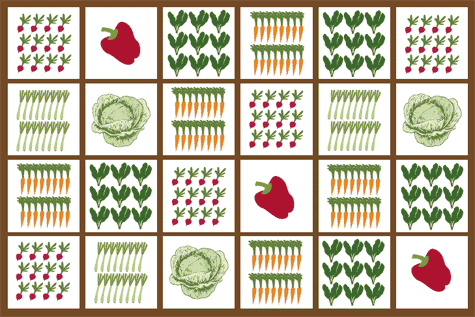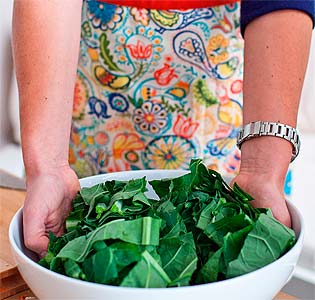
Illustration by Bambi Edlund
Considering a home garden, but don’t know where to begin? A space-efficient square foot garden is a good place to start, according to Andrea Bithell of Oak Cliff Organics. The technique, popularized by Mel Bartholomew in his book Square Foot Gardening, emphasizes planting in a compact grid pattern rather than sprawling conventional rows. The garden is sub-divided into accessible 12X12 inch squares, each devoted to only one or two types of plants. “Planting and weeding are more manageable,” says Bithell. “There’s less water wasted, and it’s super easy to plan.” Andrea’s Advice
- What’s your purpose? Consider what matters most. Do you want to grow vegetables? Herbs? Flowers? Create a wildlife habitat, a butterfly garden? Or perhaps, all of these. “I love planting marigolds in vegetable gardens,” say Bithell. “They protect against aphids, they’re beautiful, and you can eat the petals, which have a spicy taste.”
- Where and how big? As Bithell walks the property with her clients, she looks for a spot that gets a six to eight hours of sun each day, preferably morning sun. “Configuration can be whatever you wish. Size really doesn’t matter. A 12-inch width is all you need.”
- In-ground or raised bed? The square foot gardening method can be applied to any space, even a pot. Though most people prefer constructing raised beds, Bithell likes working in-ground, when possible. “Native soil, mixed with good compost and amendments, works really well, and I feel much more connected to the earth.”
- What to grow? “Of course, it depends on the season,” says Bithell, “If it’s a vegetable garden, people should grow what they like to eat. I also encourage folks to try something new. Even if you don’t like broccoli—or think you don’t—when you grow it, it’s got to be good, right?”
- How do you prepare the soil? For a raised bed, Bithell puts down newspaper (to block out weeds) then builds a frame from untreated wood and fills it with an organic mix of soil, compost and amendments. A frame can also be made of stone or cinder blocks. For an in-ground garden, which requires a bit more digging, she amends the existing dirt.
- How many plants? The size of the mature plant determines how many will be planted in each square unit. For larger plants, like broccoli, there will only be one plant per square. With small plants like radishes, there can be as many as 16. “Sometimes I do companion planting,” says Bithell, “with two types of vegetables per square foot. I like growing basil with tomatoes because it enhances the flavors.”
- Did you know? “The most common cause of plant failure is over-watering,” Bithell warns. “Water everything well, but don’t overdo. Because it’s a contained space, a square foot garden is more water efficient.”
- Anything else? Don’t forget a top layer of mulch. The crunched-up leaves and decomposed shredded bark serve as a covering, which holds in moisture, hinders weeds and as it decomposes, adds nutrients and provides a home for beneficial insects.
- Voilà – a garden is born! In approximately six to ten weeks, depending on what you’ve planted, you’ll be enjoying the fruits of your labor.
- Need extra help? Your local gardening store has plenty of experts who will be happy to guide you. For extra support, a gardening coach, like Bithell, will assist with planting and beyond. “I offer weekly services like weeding, bug checks, foliar feedings, plant maintenance and give suggestions for seasonal plant replacements.” “Growing your own food organically is good for your body and the environment,” says Bithell. “This is a gift my parents and grandparents gave me, and I love sharing that knowledge with others.”
Andrea Bithell, Oak Cliff Organics
www.oakclifforganics.com, 972.822.5010
WHAT’S FRESH?

MARCH – APRIL
(Availability will vary depending on
farm’s location and weather conditions)
| Arugula Beets, Beet Greens Broccoli Brussels Sprouts Cabbage Carrots Celery Collards Garlic Greens Green Onions Kale Lettuc |
Mizuna Mushrooms Mustard Greens Radishes Snow Peas Spinach Swiss Chard Turnips, turnip greens Herbs
|
APRIL INTO MAY
| Asparagus Cucumbers New potatoes Early onions |
Cling peaches Snap beans Squash Strawberries Early tomatoes |
This compilation was a collaborative effort of Eden’s Organic CSA
Farm, Barking Cat Farms, Akin Farms, Moss Gathers Farm, Texas
Daily Harvest and Comeback Creek Farm.
As a kid, TERRI TAYLOR refused to eat her vegetables. Her veggie-phobia was cured in 1977 when she spent eight months working on farms in Norway and France. She studied journalism at UT-Austin and received a master’s degree in liberal arts from SMU. Her short story “Virginia” can be found in Solamente en San Miguel, an anthology celebrating the magical Mexican town of San Miguel de Allende. She has written for Edible DFW since its inaugural issue in 2009. She became the magazine’s editor in 2010 and is the editor of Edible Dallas & Fort Worth: The Cookbook.
-
Terri Taylorhttps://www.edibledfw.com/author/ttaylor/
-
Terri Taylorhttps://www.edibledfw.com/author/ttaylor/
-
Terri Taylorhttps://www.edibledfw.com/author/ttaylor/
-
Terri Taylorhttps://www.edibledfw.com/author/ttaylor/











